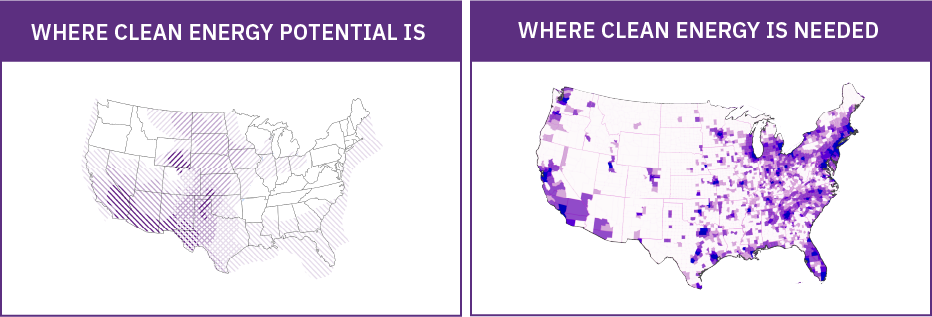Resource Hub
Transmission 101
Did you know? There are enough renewable energy projects in development today to reach 80% clean energy. There’s just one problem: We don’t have the transmission infrastructure to transport all that clean energy from the places where it’s generated to the places where we live, work, and play.
In order to support a 21st-century economy, we need a 21st-century grid — and that means we need to expand and improve our transmission infrastructure.
What Is the Transmission Grid?
Transmission lines are large wires that move electricity from where it’s created to where it’s used, often over long distances. Like our roads and bridges, transmission infrastructure is vital to our modern way of life — but the lines we have today are either too old or too small to deliver all the energy we need, and sometimes they don’t exist at all in the places we need them most.
Building more transmission lines will create jobs, improve reliability, lower electricity bills, and accelerate the clean energy transition.
To power a prosperous 21st century economy, the US will need to build 91,000 miles of new transmission lines within the next 13 years. Developing this transmission infrastructure would deliver enormous benefits, including:
Create New Jobs
Investing in transmission infrastructure could create more than 3.3 million jobs nationwide, especially in rural areas.
Improve Reliability
Summers are getting hotter, and winters are bringing more intense storms. Transmission infrastructure can help ensure energy reliability, even when extreme temperatures hit. A strong transmission grid will make it easier for utilities to coordinate resources over a wide geographic footprint to help keep the lights on. A strong transmission grid also enables more new, clean resources to connect to the grid, a process known as “generator interconnection.”
Currently, a lack of transmission capacity and outdated interconnection processes are slowing the process of getting new, clean resources online. To delve deeper into understanding the intricacies of interconnection and its pivotal role in our energy landscape, explore the ‘Interconnection ‘-related resources available in the ‘General Transmission Resources’ section of the resource hub.

Lower Electricity Bills
Provide $2.3 billion in energy cost savings for the lower 80% of income earners and save the average household $300 per year. That’s more money back in the pockets of families and small business owners.
Accelerate The Clean Energy Transition
Today, 15 states hold two-thirds of the country’s clean energy potential, but they only consume one-third of the nation’s total energy. With robust transmission infrastructure, we can deliver clean energy to everyone, wherever they live.
Cultivate Healthy Communities
Millions of Americans today live within three miles of a fossil fuel plant, and a disproportionate number of them are Black and Hispanic. This proximity increases exposure to air pollution, which is linked to respiratory illness and millions of premature deaths every year. Building transmission lines will allow us to transport clean energy to everyone and bring on more clean energy, so all of us can breathe freely.
If we are smart about how we site new lines, improve the existing grid, and work together across state and regional boundaries to deliver reliable, affordable, renewable energy to everyone, we can unlock the clean energy future.
In The News
- The US power grid isn’t ready for climate change
- Sweltering heat tests Texas’ power grid and patience as thousands in South still without electricity
- Extreme heat means two-thirds of North America could suffer blackouts this summer
- As another winter storm strains the electric grid, it’s time to fix transmission, experts say